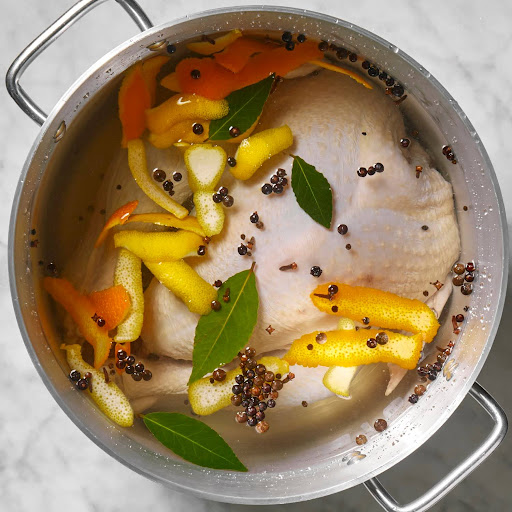Brines 101: What Culinary School Taught Me About Juicy, Flavorful Meat
Hello Chefs,
This week in culinary school, we dove into something that has completely changed the way I think about seasoning and cooking meat: brines.
If you’ve ever wondered how to make your chicken juicier, your pork chops more flavorful, or your Thanksgiving turkey actually memorable, the answer is probably brining.
Let’s break it all down—what brines are, the difference between wet and dry brining, what they actually do, and when to use which method.

So, What Is a Brine?
A brine is a salt-based treatment that helps enhance the flavor, texture, and juiciness of food—especially proteins like meat and poultry. Salt works on a molecular level to help meat retain moisture during cooking, while also seasoning it more deeply than surface seasoning alone.
There are two main types: wet brines and dry brines—and both have their place.
Wet Brines
A wet brine is a mixture of water, salt, and sugar, often enhanced with herbs, citrus, garlic, or spices for flavor. The food is fully submerged in this mixture and left to soak—usually for several hours or overnight.
What it does:
- Infuses moisture and flavor
- Helps prevent drying out, especially with lean cuts
- Can slightly alter texture (especially with poultry)
Best for:
- Whole chickens and turkeys
- Pork chops or tenderloins
- Shrimp (for short brines—just 15 to 30 minutes)
- Any meat at risk of drying out
Culinary School Tip:
We used a 1:1 ratio of kosher salt to sugar in our wet brines. A good base ratio is:
- ½ cup salt + ½ cup sugar per 6 cups of water
Other pro tips:
- Always refrigerate while brining
- Pat food very dry before cooking to promote browning
- Don’t reuse brine (it’s a one-time bath)
Dry Brines
A dry brine is as simple as it sounds—just rub salt (and optionally sugar or spices) directly onto the surface of the food, then let it rest in the fridge. No water required.
What it does:
- Deeply seasons the meat
- Helps retain natural juices
- Produces crispier skin and better browning
Best for:
- Steaks
- Chicken parts (especially thighs or breasts)
- Pork roasts
- Anything where you want a drier exterior or crispy crust
Tip:
You can still follow the equal parts salt and sugar rule here. Just mix the two and rub it on the meat. Let it rest uncovered in the fridge for 12–24 hours. The salt draws out moisture, then reabsorbs it with flavor—no rinsing necessary.
So, Which One Do You Use?
It depends on the cut of meat, your cooking method, and your texture goals:
| Food | Best Brine Type | Why |
|---|---|---|
| Whole Chicken/Turkey | Wet | Juiciness throughout, especially white meat |
| Chicken Thighs | Dry | Flavor + crisp skin |
| Pork Chops | Wet or Dry | Wet = juicier; Dry = more concentrated flavor |
| Steak | Dry | Deep seasoning without excess moisture |
| Shrimp | Wet (Short Brine) | Enhances flavor quickly, prevents overcooking |
| Duck Breast | Dry | Keeps fat dry for perfect crispy skin |
Final Thoughts
Brining might sound fancy, but it’s really just science—and a secret weapon for better food. Whether it’s a slow-roasted turkey or a quick weeknight pork chop, brining gives you tenderness, flavor, and moisture every time.
Just remember: equal parts salt and sugar is your friend. Whether wet or dry, it’s all about balance.
Until next time, stay salty and brine on!
 Brennah Van Wagoner
Brennah Van Wagoner
Weekly Newsletter Contributor since 2025
Email the author! brennah.oaks@gmail.com
